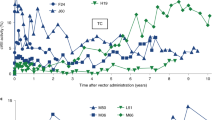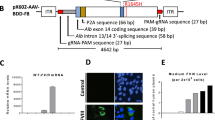Abstract
A chimeric RNA/DNA oligonucleotide was constructed to induce a sequence mutation in the rat factor IX gene, resulting in prolonged coagulation. Oligonucleotides were targeted to hepato-cytes in cell culture or in vivo by intravenous injection. Nucleotide conversion was both site-specific and dose-dependent. The mutated gene was associated in vivo with significantly reduced factor IX coagulant activity and a marked prolongation of the activated partial thromboplastin time. The results demonstrate that single base-pair alterations can be introduced in hepatocytes in situ by RNA/DNA oligonucleotides, suggesting a potentially powerful strategy for hepatic gene repair without the use of viral vectors.
This is a preview of subscription content, access via your institution
Access options
Subscribe to this journal
Receive 12 print issues and online access
$209.00 per year
only $17.42 per issue
Buy this article
- Purchase on Springer Link
- Instant access to full article PDF
Prices may be subject to local taxes which are calculated during checkout
Similar content being viewed by others
References
Chang, A.G.Y. & Wu, G.Y. Gene therapy: Applications to the treatment of gastrointestinal and liver diseases. Gastroenterology 106, 1076–1084 (1994).
Teckman, J.H., Qu, D. & Perlmutter, D.H. Molecular pathogenesis of liver disease in α1-antitrypsin deficiency. Hepatology 24, 1504–1516 (1996).
Reiner, A.P. & Davie, E.W., Metabolic and Molecular Bases of Inherited Disease. (eds. Scriver, C.R., Beaudet, A.L., Sly, W.S. & Valle, D.) 3181–3221 (McGraw-Hill, Inc., New York, 1995).
Strauss, M. Liver-directed gene therapy: Prospects and problems. Gene Ther 1, 156–164 (1994).
Bowles, N., Woo, S.L.C. Gene therapy for metabolic disorders. Advanced Drug Del. Rev. 17, 293–302 (1995).
Askari, F.K., Hitomi, Y., Mao, M. & Wilson, J.M. Complete correction of hyperbiliru-binemia in the Gunn rat model of Crigler-Najjar syndrome type I following transient in vivo adenovirus-mediated expression of human bilirubin UDP-glucuronosyltrans-ferase. Gene Ther. 3, 381–388 (1996).
Ye, X. et al. Prolonged metabolic correction in adult ornithine transcarbamylase-de-ficient mice with adenoviral vectors. J. Biol. Chem. 271, 3639–3646 (1996).
Connelly, S., Gardner, J.M., Lyons, R.M., McClelland, A. & Kaleko, M. Sustained expression of therapeutic levels of human factor VIII in mice. Blood 87, 4671–4677 (1996).
Takahashi, M. et al. Long term correction of bilirubin-UDP-glucuronosyltransferase deficiency in Gunn rats by administration of a recombinant adenovirus during the neonatal period, J. Biol. Chem. 271 26536–26542 (1996).
IIan, Y. et al. Oral tolerization to adenoviral antigens permits long-term gene expression using recombinant adenoviral vectors. J. Clin. Invest. 99 1098–1106 (1997).
Wang, G., Levy, D.D., Seidman, M.M. & Glazer, P.M. Targeted mutagenesis in mammalian cells mediated by intracellular triple helix formation. Mol. Cell. Biol.15, 1759-1768 (1995).
Beal, P.A. & Dervan, P.B. Second structural motif for recognition of DNA by oligonucleotide-directed triple-helix formation. Science 251, 1360–1363 (1991).
Thomas, K.R. & Capecchi, M.R. Site-directed mutagenesis by gene targeting in mouse embryo-derived stem cells. Cell 503–512 (1987)
Zheng, H. & Wilson, J.H. Gene targeting in normal and amplified cell lines. Nature 344, 170–173 (1990).
Sakagami, K., Tokinaga, Y., Yoshikura, H. & Kobayashi, I. Homology-associated non-homologous recombination in mammalian gene targeting. Proc. Natl. Acad. Sci. USA 91, 8527–8531 (1994).
Yoon, K., Cole-Strauss, A. & Kmiec, E.B. Targeted gene correction of episomal DNA in mammalian cells mediated by a chimeric RNA"DNA oligonucleotide. Proc. Natl. Acad. Sci. USA 93, 2071 2076 (1996).
Cole-Strauss, A. et al. 273 1386–1389 (1996).
Kmiec, E.B., Cole, A. & Holloman, W.K., REC2 gene encodes the homologous pairing protein of Ustilago maydis. Mol. Cell. Biol. 14, 7163–7172 (1994).
Kotani, H. et al. RNA facilitates RecA-mediated DNA pairing and strand transfer between molecules bearing limited regions of homology. Mol. Gen. Genet. 250 626–634 (1996).
Monia, B.P. et al. Evaluation of 2'-modified oligonucleotides containing 2'-deoxy gaps as antisense inhibitors of gene expression. J. Biol. Chem. 268, 14514–14522 (1993).
Shinohara, A., & Ogawa, T. Homologous recombination and the roles of double-strand breaks. Trends Biochem. Sci. 20, 387–391 (1995).
Kolodner, R.D. Mismatch repair: Mechanisms and relationship to cancer susceptibility. Trends Biochem. Sci. 20, 397–401 (1995).
Kren, B.T., Cole-Strauss, A., Kmiec, E.B. & Steer, C.J. Targeted nucleotide exchange in the alkaline phosphatase gene of HuH-7 cells mediated by a chimeric RNA/DNA oligonucleotide. Hepatology 25, 1462–1468 (1997).
Boussif, O. et al. versatile vector for gene and oligonucleotide transfer into cells in culture and in vivo: Polyethylenimine. Proc. Natl. Acad. Sci. USA 92, 7297–7301 (1995).
Sarkar, G., Koeberl, D.D. & Sommer, S.S. Direct sequencing of the activation pep-tide and the catalytic domain of the factor IX gene in six species. Genomics 6, 133–143 (1990).
Wong, E.A. & Capecchi, M.R. Homologous recombination between coinjected DNA sequences peaks in early to mid-S phase. Mol. Cell. Biol. 7, 2294–2295 (1987).
Yamamoto, A. et al. Cell cycle-dependent expression of the mouse RadSIgene in proliferating cells. Mol. Gen. Genet. 251,112 (1996).
Stürzbecher, H.-W., Donzelmann, B., Henning, W., Kippschild, U. & Buchhop, S. p53 is linked directly to homologous recombination processes via RAD51 /RecA protein interaction. EMBOJ. 15, 1992–2002 (1996).
Fang, W.-h. & Modrich, P. Human strand-specific mismatch repair occurs by a bidirectional mechanism similar to that of the bacterial reaction. J. Biol. Chem. 268, 11838–11844 (1993).
Umar, A., Boyer, J.C. & Kunkel, T.A. DNA loop repair by human cell extracts. Science 266, 814–816 (1994).
Klungland, A. & Lindahl, T. Second pathway for completion of human DNA base excision-repair: Reconstitution with purified proteins and requirement for DNase IV (FEN1). EMBOJ. 16, 3341–3348 (1997).
Wood, R.D. Nucleotide excision repair in mammalian cells. J. Biol. Chem. 272, 23465–23468 (1997).
Wellinger, R.E. & Thoma, F. Nucleosome structure and positioning modulate nucleotide excision repair in the non-transcribed strand of an active gene. EMBOJ. 16, 5046–5056 (1997).
Bulla, G.A., DeSimone, V., Cortese, R. & Fournier, R.E. Extinction of arantitrypsin gene expression in somatic cell hybrids: Evidence for multiple controls. Genes Dev. 6, 316–327 (1992).
Prouty, S.M. et al. A cell culture model system for genetic analyses of the cell cycle by targeted homologous recombination. Oncogene 8, 899–907 (1993).
Arbonés, M.L., Austin, H.A., Capon, D.J. & Greenburg, G. Gene targeting in normal somatic cells: Inactivation of the interferon-y receptor in myoblasts. Nature Gen. 6, 90–97 (1994).
Fan, G., Ma, X., Kren, B.T. & Steer, C.J. The retinoblastoma gene product inhibits TGF-ß1 induced apoptosis in primary rat hepatocytes and human HuH-7 hepatoma cells. Oncogene 12, 1909–1919 (1996).
Gray, G.R. The direct coupling of oligosaccharides to proteins and derivatized gels. Arch. Biochem. Biophys. 163, 426–428 (1974).
Abdallah, B. et al. A powerful nonviral vector for in vivogene transfer into the adult mammalian brain: Polyethylenimine. Hum. Gene Ther. 7, 1947–1954 (1996).
Kren, B.T., Trembley, J.H.,& Steer, C.J. Alterations in mRNA stability during rat liver regeneration. Am. J. Physiol. 270, G763–G777 (1996).
Melchior, W.B.,& Von Hippel, P.H. Alteration of the relative stability of dA.dT and dG.dC base pairs in DNA. Proc. Natl. Acad. Sci. USA 70, 298–302 (1973).
Author information
Authors and Affiliations
Rights and permissions
About this article
Cite this article
Kren, B., Bandyopadhyay, P. & Steer, C. In vivo site-directed mutagenesis of the factor IX gene by chimeric RNA/DNA oligonucleotides. Nat Med 4, 285–290 (1998). https://doi.org/10.1038/nm0398-285
Received:
Accepted:
Issue Date:
DOI: https://doi.org/10.1038/nm0398-285
This article is cited by
-
Studies on the interactions of polymer-anchored copper(II) complexes with tRNA
Transition Metal Chemistry (2010)
-
A comparison of synthetic oligodeoxynucleotides, DNA fragments and AAV-1 for targeted episomal and chromosomal gene repair
BMC Biotechnology (2009)
-
Gentherapie von hereditären Lebererkrankungen
Der Gastroenterologe (2008)
-
PEI/EVAL blend membranes for granule neuronal cell culture
Journal of Polymer Research (2007)



